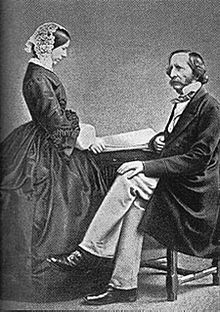Paulina Jermyn Trevelyan (1816-1866)
May 17, 2013
 Paulina
Jermyn Trevelyan
(1816-1866)
‘… was an English painter, married in May 1835 to Sir Walter
Calverley
Trevelyan, 6th
Baronet. She is noted for having single-handedly made Wallington
Hall in Northumberland a centre of High Victorian cultural life, and
enchanting by her intellect and art,
John Ruskin,
Algernon
Chales Swinburne, Elizabeth
Barrett
Browning, Robert
Browning, Christina
Georgina
Rossetti, Dante
Gabriel
Rossetti, William
Michael
Rossetti, Thomas
Carlyle,
and John
Everett Millais and
other members of the Pre-Raphaelite Brotherhood…’
Paulina
Jermyn Trevelyan
(1816-1866)
‘… was an English painter, married in May 1835 to Sir Walter
Calverley
Trevelyan, 6th
Baronet. She is noted for having single-handedly made Wallington
Hall in Northumberland a centre of High Victorian cultural life, and
enchanting by her intellect and art,
John Ruskin,
Algernon
Chales Swinburne, Elizabeth
Barrett
Browning, Robert
Browning, Christina
Georgina
Rossetti, Dante
Gabriel
Rossetti, William
Michael
Rossetti, Thomas
Carlyle,
and John
Everett Millais and
other members of the Pre-Raphaelite Brotherhood…’
In 1850, Paulina Jermyn Trevelyan was a patient of Elizabeth (Eliza) Hetty Hall Wagstaff, and she took homeopathic remedies (John Batchelor, Lady Trevelyan and the Pre-Raphaelite Brotherhood, (Random House, 31 Dec 2011). Page 227). In 1860, Paulina Jermyn Trevelyan was a close friend of Georgiana Tollemache Mount Temple (James Gregory, Reformers, Patrons and Philanthropists, (Taurus Academic Studies, 2010). Page 94).
From [http://en.wikipedia.org/wiki/Pauline,*Lady\_Trevelyan\](http://en.wikipedia.org/wiki/Pauline,\_Lady\_Trevelyan) ‘… _Paulina (known as Pauline) Jermyn was the eldest child of George Bitton Jermyn (b. 1789) of Hawkedon Parsonage, who, to ensure the Jermyn surname survived, added it as her second Christian name. Her mother was of Hugenot descendancy. *
*The marriage between artist Pauline Jermyn, the penniless daughter of a clergyman and the rich, teetotal, vegetarian Sir Walter Calverley Trevelyan was an unlikely, but not surprisingly successful arrangement—their common interest in geology and art ensured their compatibility and the childless marriage allowed them to channel their creativity to other ends. *
*William Bell Scott said of her, *
“a true woman, but without vanity, and very likely without the passion of love.”
_Shortly before proposing to Pauline, Walter had made his future wife a gift of a box of fossils. Walter had been described as “an intellectual of a dry professional order”. He was the owner of Wallington estate from 1846 until his death . Besides being a distinguished geologist, he had a great interest in botany and was an authority on farming methods, winning awards for his cattle. His strict views on alcohol led to the dumping of his father’s wine collection into a nearby lake. _
_Pauline had met him in 1833 at a Cambridge conference of the British Association for the Advancement of Science. She had been schooled in Greek, French, Latin, German, and Italian, and her interests were science, literature and the fine arts. She wrote pieces for the Edinburgh Review and The Scotsman. On her first visit to her husband’s family at Wallington, she was inspired by Richard Grainger and John Dobson’s redevelopment of nearby Newcastle. _
Walter may have been a respected scientist, but he was eclipsed by Pauline who had become the focal point for an enormous array of poets, painters and writers. It was during this period that the Central Hall evolved. In earlier days the house was surrounded by an unattractive courtyard, until Ruskin suggested that it be roofed, so that in 1855 this was done under his and John Dobson’s supervision. Ruskin is said to have designed the first floor balustrade. William Bell Scott, then an art teacher in Newcastle, with help from Pauline, Ruskin and Arthur Hughes, painted panels in the Hall showing figures and scenes from the history of Northumberland in Pre-Raphaelite style.
Pauline was buried at Neuchatel. Every year, many visitors come to appreciate her contribution to humanity…’